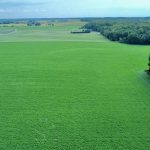Canada must stand up to the United States to protect its cattle industry, says an Alberta producer promoting ideas on how to rescue producers from the BSE crisis.
“If Canada is going to exist in the cattle industry, we have no choice but to risk offending our neighbour to the south that has so much control over us,” Cam Ostercamp, head of the Beef Initiative Group, told about 300 producers at a June 22 meeting in Camrose.
Ostercamp has a package of ideas that includes building a producer-owned packing plant large enough to compete with Cargill and Lakeside and conducting 100 percent BSE testing in that plant on beef slated for Asia.
Read Also

Canadian-bred cow wins World Dairy Expo Holstein show
A cow bred in Saskatchewan, Lovhill Sidekick Kandy Cane, is the Grand Champion Holstein at the 2025 World Dairy Expo.
Choosing to do more BSE testing, especially for the Japanese market, may offend the U.S., said Ostercamp, who is travelling to communities in Alberta and Saskatchewan to rally grassroots support for his ideas.
“If we’re going to get out of this pickle, it’s going to be at the producer level. The government has demonstrated there’s not much will to change the status quo,” said Ostercamp. “There’s plenty of evidence to suggest the border opening will never be our salvation.”
Not everyone in the audience believed that the Japanese government would reopen its border to Canadian cattle and beef if 100 percent testing was adopted.
Jackie Littler of Boyle, Alta., warned the group that producers better have a firm contract before they build a packing plant with BSE-testing equipment.
All Canadian deer and elk are tested for chronic wasting disease, but the Japanese border is still not open to deer and elk, he added.
“If we’re going to test, I suggest we have a contract in hand before we go through all that work.”
Dave Solverson of Camrose said he’s opposed to 100 percent testing because it would be expensive and unnecessary. However, he supported the idea of testing animals for a specific market.
He worried that if Canada began testing all animals for Japan, the requirement would only last a month and the expense would be wasted.
Ostercamp said he believes Japan is still rigid in its belief that 100 percent of the animals must be tested.
“If something as simple as slaughter plant testing has the potential to turn this thing around, we’d better get our head around it,” he said.
Breaking into the Asian market is key to shifting exports from the U.S. to Asia and making Canada less dependent on the large U.S. market. A producer-funded processing plant dedicated to shipping beef to Asia would help wean Canada off its reliance with the U.S.
“A producer-funded slaughter plant in this country very well may be the answer,” Ostercamp said.
Jim Townsend of Edmonton said a producer plant would have to slaughter at least 1,500 head a day to ensure that it is competitive with the large packing plants.
“(Your belief) that establishing 100 percent testing in a plant is pivotal to establishing markets may be true, but without a competitive infrastructure owned and controlled by primary producers, you haven’t got a hope in hell of making the thing go in the long term,” said Townsend.
Dale Fankhanel of Ferintosh, Alta., pointed to the farmer-owned Fletcher’s hog slaughtering plant as a good idea until the provincial government eliminated the single desk selling system.
“I don’t know if we can build a plant big enough to compete with those guys,” he said.
Rob Livingston of Vermilion said while he applauds Ostercamp and his group for raising the issues, any solution might be too far in the future to save producers.
“An awful lot of farmers aren’t going to last that long.”
Bob Prestage, a cattle producer and exporter from Camrose, said he agrees that Canadians need to regain control of their packing industry, but recognizes it’s not going to happen quickly.
“Don’t go running around half cocked and think you’re going to turn the world around in 20 minutes,” said Prestage.
He noted it took 10 years of talking and negotiating before he made his first Japanese sale.
“We just got to slowly take back our market.”














